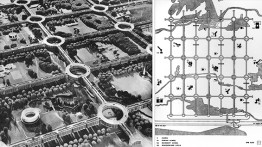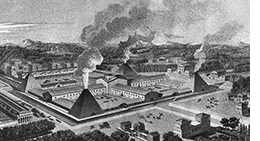An Ideal View: City Plans Without Cities
Mon, May 4, 2020 12pm - Mon, Jun 22, 2020 11:59pm

Motopia, Geoffrey A. Jellicoe et al., ca. 1960
“They would reconstruct society on an imaginary plan, much like the astronomers for their own calculation would make over the system of the universe.”
–Pierre-Joseph Proudhon, on the utopian socialists
The Irwin S. Chanin School of Architecture Archive is pleased to present a selection of city plans from its collection of over 10,000 4” x 5” lantern slides. The collection, which was donated to the Archive by Cooper Union’s Library in 1987, was formerly used to teach History of Architecture and Town Planning. It documents historical sites, architecture, painting, sculpture, manuscripts, city planning, drawings, jewelry, and mosaics from ancient history through the 20th century. The plans in this exhibition—now presented online—were originally curated by Patrick McElnea and presented in 2013 as a series of prints in the School’s 3rd floor hallway gallery.

The lantern slide is a positive, glass-mounted transparency designed to be backlit by a bulb or oil lamp and projected through a magnifying lens. Although the technology predates photography, the “magic lantern” format was integral to the development of visual disciplines from the late 19th century through the 1950s. As a vital tool for research and pedagogy, lantern slides were commonly used to teach architectural history, and most of the Archive’s collection documents extant structures. This exhibition, however, focuses on city planning proposals and reconstructions of ruins that have never left the page or model pedestal—none of these slide images represent existing architecture.
The lantern slides presented here illustrate a diverse array of representational techniques, formal strategies, and pictorial languages. Proposals for unrealized projects highlight the influence of image technologies on architectural planning. That we cannot experience these proposals make us especially dependent on their graphic legibility. The images in this exhibition are composed of individual slides cropped at their original borders, captioned from text typed above each slide image, and grouped by structural similarities or types. The resulting images vary broadly—from examples of isolated communities and divergent approaches to the natural condition of a river to Louis Kahn’s unrealized planning proposals for Philadelphia and Ledoux’s 18th century proposal for a canon foundry. Removed from the lecturer’s historical and discursive context, these images provide a glimpse of the myriad ways in which imaginary structures and cities have been realized not in our built environment, but in our collective imagination.




